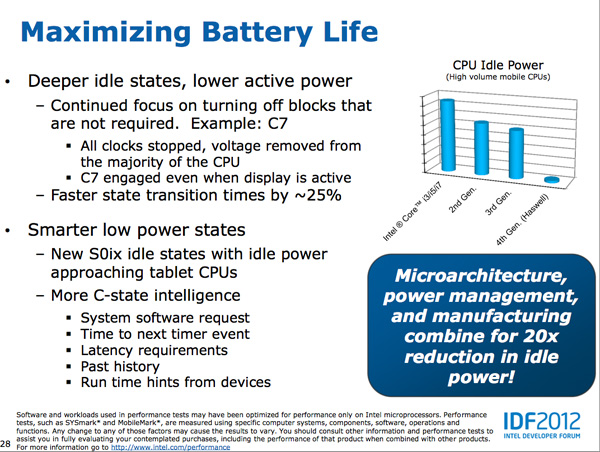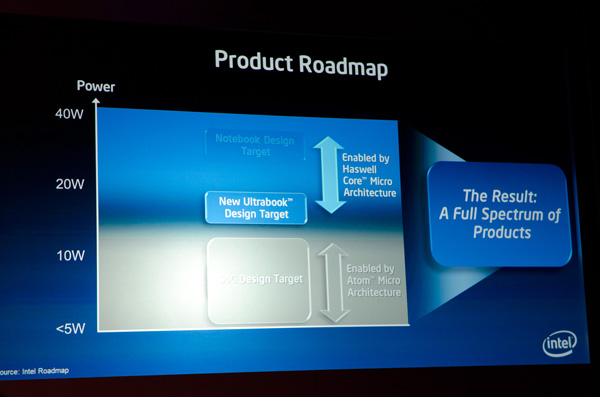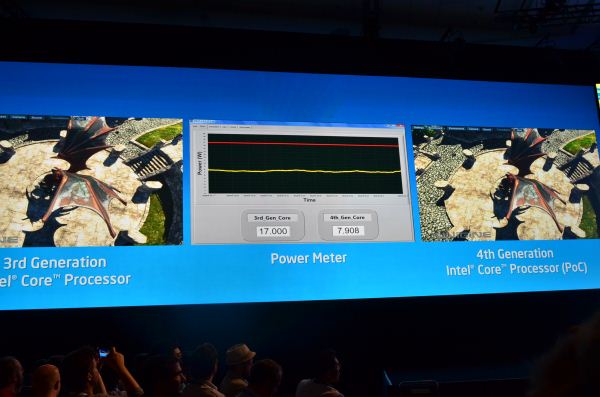Intel's Haswell Architecture Analyzed: Building a New PC and a New Intel
by Anand Lal Shimpi on October 5, 2012 2:45 AM ESTOther Power Savings
Haswell's power savings come from three sources, all of which are equally important. We already went over the most unique: Intel's focus on reducing total platform power consumption by paying attention to everything else on the motherboard (third party controllers, voltage regulation, etc...). The other two sources of power savings are more traditional, but still very significant.

At the micro-architecture level Intel added more power gating and low power modes to Haswell. The additional power gating gives the power control unit (PCU) more fine grained control over shutting off parts of the core that aren't used. Intel published a relatively meaningless graph showing idle power for standard voltage mobile Haswell compared to the previous three generations of Core processors.
Haswell can also transition between power states approximately 25% faster than Ivy Bridge, which lets the PCU be a bit more aggressive in which power state it selects since the penalty of coming out of it is appreciably lower. It's important to put the timing of all of this in perspective. Putting the CPU cores to sleep and removing voltage/power from them even for a matter of milliseconds adds up to the sort of savings necessary to really enable the sort of always-on, always-connected behavior Haswell based systems are expected to deliver.
Intel has also done a lot of work at the process level to bring Haswell's power consumption down. As a tock, Haswell is the second micro-architecture to use Intel's new 22nm tri-gate transistors. The learnings from Ivy Bridge are thus all poured into Haswell. Intel wasn't too specific on what it did on the manufacturing side to help drive power down in Haswell other than to say that a non-insignificant amount of work came from the fabs.
The Fourth Haswell
At Computex Intel's Mooly Eden showed off this slide that positioned Haswell as a 15-20W part, while Atom based SoCs would scale up to 10W and perhaps beyond:
Just before this year's IDF Intel claimed that Haswell ULT would start at 10W, down from 17W in Sandy/Ivy Bridge. Finally, at IDF Intel showed a demo of Haswell running the Unigen Heaven benchmark at under 8W:
The chain of events tells us two things: 1) Intel likes to play its cards close to its chest, and 2) the sub-10W space won't be serviced by Atom exclusively.
Intel said Haswell can scale below 10W, but it didn't provide a lower bound. It's too much to assume Haswell would go into a phone, but once you get to the 8W point and look south you open yourself up to fitting into things the size of a third generation iPad. Move to 14nm, 10nm and beyond then it becomes more feasible that you could fit this class of architecture into something even more portable.
Intel is being very tight lipped about the fourth client Haswell (remember the first three were desktop, mobile and ultra-low-volt/Ultrabook) but it's clear that it has real aspirations to use it in a space traditionally reserved for ARM or Atom SoCs.
One of the first things I ever heard about Haswell was that it was Intel's solution to the ARM problem. I don't believe a 10W notebook is going to do anything to the ARM problem, but a sub-8W Haswell in an iPad 3 form factor could be very compelling. Haswell won't be fanless, but Broadwell (14nm) could be. And that could be a real solution to the ARM problem, at least outside of a phone.
As I said before, I don't see Haswell making it into a phone but that's not to say a future derivative on a lower power process wouldn't.













245 Comments
View All Comments
stop-a - Saturday, October 6, 2012 - link
100% agree on the well engineered part especially on the antenna gate when Steve God was saying "you're holding wrong", plus the recently ingeniously designed sapphire glass lens camera when Tim Schmok was saying "stay away from bright light source". Boy, Apple products must be engineered straight from the heaven; they are just too perfect for a mere earthling to use.Paer0 - Saturday, October 6, 2012 - link
@stop-a. Since you are a 100% Apple hater, let me ask you this what computer do you use? And what OS do you use on it? I hope it doesn't crash several times a day. I use a MacBook Pro 2012 and I don't see anything come close.Urizane - Saturday, October 6, 2012 - link
You really shouldn't use the 'crash several times a day' piece anymore. I'm annoyed every time I see this. My Windows 7 machine has an uptime of 20 days and counting. Most of the time, it waits for me to connect to it via SplashTop or FTP, or it's recording TV shows, but when I play games, I stress it bigtime. Seriously, stop with the Windows constantly crashes crap. It's just plain false now.P.S. - 20 days ago, I brought it to another house, thus the interruption in uptime.
StevoLincolnite - Saturday, October 6, 2012 - link
I have a Dual socket 2011 motherboard with dual Core i7 3930K's both chips clocked to 4.6ghz, 32gb of ram, Triple Radeon 7970 3gb cards powering 3x 27" Dell U2711 monitors in Eyefinity.Kay go. Lets see if your Mac can keep up or a Mac workstation at the same price. (Hint: Not going to happen.)
Besides, Mac's look ugly, I prefer the whole she-bang of a side window with a nice water cooling loop and having the whole thing light up, not some dull silver box.
Plus, my system is completely stable. Never had a crash yet with Windows 7 and... I have access to the last couple of decades worth of software and games, not to mention emulation of other platforms.
I can also pretty much find software and hardware easily and it will "just work" I never have to ask the question of: Will it work on a Mac?
lmcd - Saturday, October 6, 2012 - link
I don't think you're in their target audience, for some reason. They're the best preconfigured system out there, especially once you ignore price.Magik_Breezy - Sunday, October 14, 2012 - link
You'd hope a manufacturer can "configure" a system for an extra $1,400Hardware: $400
I'm Apple: $1,400
Total: $1,800
With PCs manufacturers almost always loose money selling motherboards
vt1hun - Tuesday, October 9, 2012 - link
Two Core i7s working on a dual 2011 socket motherboard? You need QPI links for that which only certain Xeons have. Sounds like your system will just NOT work !FunBunny2 - Tuesday, October 9, 2012 - link
If Steve hadn't done what Apple does best (according to Steve) "steal" BSD unix, would you still be crowing?Magik_Breezy - Sunday, October 14, 2012 - link
His operating system doesn't crash 7 times a day because he doesn't run OS X, I'll rephrase that, because he isn't a retardHisDivineOrder - Sunday, October 7, 2012 - link
Let's not forget the obscenely high failure rates due of Macbook Pro's because they are huge, metallic, and yet refuse to have vents ruin the smooth awesomeness of their aesthetic.Whoops, for many it won't last more than two years, if that. Hell, if you're lucky, your battery will give out before your laptop cooks. Regardless, look up what Apple suggests and you'll get:
Buy another one. Yours is old. ;)